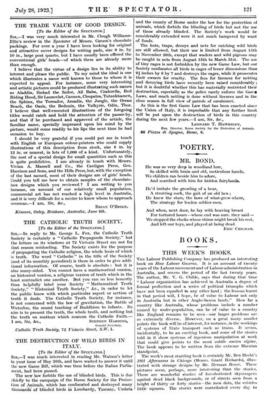BOOKS.
THIS WEEK'S BOOKS.
TEE Labour Publishing Company has produced an interesting book on How Labour Governs. It is un account of twenty years of the Labour movement and of Labour administration in Australia, and covers the period of the last twenty years. The author, Mr. V. G. Childe, says that during that time " Labour organization has achieved in Australia a degree of formal perfection and a series of political triumphs which have not been equalled in any other land ; the lessons learnt in that period will, I hope, be of value to Labour not only in Australia but in other Anglo-Saxon lands." How far a country like Australia, whose problems include a number caused by under-population, can be of value to a country like England remains to be seen—our larger problems arc so extremely diverse. However, on a great ninny smaller points the book will be of interest, for instance, in the workings of systems of State transport such as trams. It seems, incidentally, to be an exciting book, and some of the stories told in it show systems of ingenious manipulation at work that could give points to the most subtle ancien regime. The book appears to be written from the extreme Marxian standpoint.
The week's most startling book is certainly Mr. Ben Hecht's 1001 Afternoons in Chicago (Messrs. Grant Richards), illus- trated with strange designs by Mr. Herman Rosse. These pictures seem, perhaps, more interesting than the stories. There are wonderful studies of foreshortened skyscrapers against dead black backgrounds, or of streets seen from a height of thirty or forty stories—the men dots, the vehicles little squares. The stories were contributed every day to the Chicago Daily News, and seem to be superior " write-ups " of the day's news—that is to say, Mr. Hecht went out as a reporter and returned as a novelist. The idea was an extremely good one, but seems to have been somewhat noisily carried out.
Professor Hearnshaw has edited a series of lectures on The Social and Political Ideas of Some Great Mediaeval Thinkers (Messrs. Harrap), such as St. Augustine, St. Thomas Aquinas, and Dante. There is one on Pierre Du Bois by Dr. Eileen Power. Such a series is bound to be interesting. Very attractive is a study in comparative folklore by the Vicar of St. Albans, Dr. Oesterley, The Sacred Dance (The Cambridge University Press). It is a fascinating and scholarly work. To us, perhaps, particularly interesting are the studies in the dances that are alluded to in the Old 71Pstament. There are chapters on " The Ecstatic Dance," " The Sacred Dance as a Marriage Rite," " Dancing as a Mourning and Burial Rite," " The Ritual Dance Round a Sacred Object," and on dances " In Honour of Supernatural Powers." We can find no allusion, however, to what is said to be the one sacred dance left in Christian ritual, that is, the dance of the choristers on Corpus Christi Day in front of the High Altar in Seville Cathedral. We particularly com- mend to our readers some very interesting comments on the Psalms.
There are three interesting books on India, all published by Mr. Humphrey Milford : The English Factories in India, by William Foster ; a study of Hindu Political Theories, by Professor Ghoshal ; and a saga of Rajput chivalry, The Lay of Atha, partly translated by the late
Mr. William Waterfield, with an introduction and summary by Sir George Grierson. There are no novels of particular note.
THE LITERARY EDITOR.







































 Previous page
Previous page